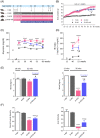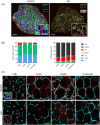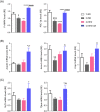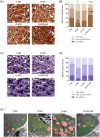AdipoRon enhances healthspan in middle-aged obese mice: striking alleviation of myosteatosis and muscle degenerative markers
- PMID: 36513619
- PMCID: PMC9891981
- DOI: 10.1002/jcsm.13148
AdipoRon enhances healthspan in middle-aged obese mice: striking alleviation of myosteatosis and muscle degenerative markers
Abstract
Background: Obesity among older adults has increased tremendously. Obesity accelerates ageing and predisposes to age-related conditions and diseases, such as loss of endurance capacity, insulin resistance and features of the metabolic syndrome. Namely, ectopic lipids play a key role in the development of nonalcoholic fatty liver disease (NAFLD) and myosteatosis, two severe burdens of ageing and metabolic diseases. Adiponectin (ApN) is a hormone, mainly secreted by adipocytes, which exerts insulin-sensitizing and fat-burning properties in several tissues including the liver and the muscle. Its overexpression also increases lifespan in mice. In this study, we investigated whether an ApN receptor agonist, AdipoRon (AR), could slow muscle dysfunction, myosteatosis and degenerative muscle markers in middle-aged obese mice. The effects on myosteatosis were compared with those on NAFLD.
Methods: Three groups of mice were studied up to 62 weeks of age: One group received normal diet (ND), another, high-fat diet (HFD); and the last, HFD combined with AR given orally for almost 1 year. An additional group of young mice under an ND was used. Treadmill tests and micro-computed tomography (CT) were carried out in vivo. Histological, biochemical and molecular analyses were performed on tissues ex vivo. Bodipy staining was used to assess intramyocellular lipid (IMCL) and lipid droplet morphology.
Results: AR did not markedly alter diet-induced obesity. Yet, this treatment rescued exercise endurance in obese mice (up to 2.4-fold, P < 0.05), an event that preceded the improvement of insulin sensitivity. Dorsal muscles and liver densities, measured by CT, were reduced in obese mice (-42% and -109%, respectively, P < 0.0001), suggesting fatty infiltration. This reduction tended to be attenuated by AR. Accordingly, AR significantly mitigated steatosis and cellular ballooning at liver histology, thereby decreasing the NALFD activity score (-30%, P < 0.05). AR also strikingly reversed IMCL accumulation either due to ageing in oxidative fibres (types 1/2a, soleus) or to HFD in glycolytic ones (types 2x/2b, extensor digitorum longus) (-50% to -85%, P < 0.05 or less). Size of subsarcolemmal lipid droplets, known to be associated with adverse metabolic outcomes, was reduced as well. Alleviation of myosteatosis resulted from improved mitochondrial function and lipid oxidation. Meanwhile, AR halved aged-related accumulation of dysfunctional proteins identified as tubular aggregates and cylindrical spirals by electron microscopy (P < 0.05).
Conclusions: Long-term AdipoRon treatment promotes 'healthy ageing' in obese middle-aged mice by enhancing endurance and protecting skeletal muscle and liver against the adverse metabolic and degenerative effects of ageing and caloric excess.
Keywords: adiponectin; ageing; endurance; intramyocellular lipids; myosteatosis; nonalcoholic fatty liver disease.
© 2022 The Authors. Journal of Cachexia, Sarcopenia and Muscle published by John Wiley & Sons Ltd on behalf of Society on Sarcopenia, Cachexia and Wasting Disorders.
Conflict of interest statement
Authors declare that no conflict of interest exists.
Figures








References
Publication types
MeSH terms
Substances
Grants and funding
LinkOut - more resources
Full Text Sources
Medical
Research Materials
Miscellaneous

